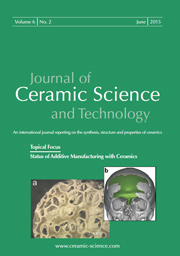Articles
All articles | Recent articles
Development of Novel ZnO-Doped Hydroxyapatite Polycarboxylate Dental Cement
Y. E. Greish1, S. H. Kenawy2, S. I. Habib3, T. A. Moussa3, H. A. Shalaby4, M. El Deftar 5
1 Department of Chemistry, Faculty of Science, United Arab Emirates University, Al Ain, United Arab Emirates
2 Department of Chemistry, Faculty of Science, Jazan University, Saudi Arabia
3 Biomaterials Department, Faculty of Oral and Dental Medicine, Cairo University, Cairo, Egypt
4 Biomaterials Department, Misr International University, Cairo, Egypt
5 Tissue Culture and Cytogenetics Unit, National Cancer Institute, Cairo University, Cairo, Egypt
received July 2, 2011, received in revised form August 12, 2011, accepted August 26, 2011
Vol. 2, No. 4, Pages 227-236 DOI: 10.4416/JCST2011-00022
Abstract
Calcium phosphate cements (CPCs) have been clinically used for the past fifteen years in different hard-tissue-related applications. The end-product of a set CPC is normally a hydroxyapatite (Ca10(PO4)6(OH)2; HAp), which has structural and morphological similarity to the mineral part in these hard tissues. Similar to ceramic materials, CPCs have the disadvantage of being brittle, which limits their applications to non-load bearing applications. The addition of a ductile ingredient, such as biocompatible polymers, has been suggested as a reasonable avenue to solve these problems. The current study deals with the development of a novel cement comprising CPC with polyacrylic acid (PAA) in addition to ZnO as an accelerator. The physical, structural, mechanical, and biological performance of this cement has been evaluated. Results showed that two types of cements could be used in which dried or calcined HAp represents the CPC constituent of the cement, and that the addition of 20 – 30 % by weight of ZnO showed enhanced properties compared to ZnO-free cements. The enhanced reactivity of calcined HAp with PAA, compared to that of dried HAp, was reflected in a more stable non-toxic cement that is highly recommended as a potential bone/dental cement, and which is characterized by its high bioactivity.
![]() Download Full Article (PDF)
Download Full Article (PDF)
Keywords
Hydroxyapatite, dental cement, polycarboxylate, in vitro performance, stem cells
References
1 Jarcho, M.: Calcium phosphate ceramics as hard tissue prosthetics, Clin. Orthop., 157, 259 – 278, (1981).
2 Kamegaya, M., Shinohara, Y., Shinada, Y., Moriya, H., Koizumi, W., Tsuchiya, K.: The use of a hydroxyapatite block for innominate osteotomy, J. Bone Joint Surg., 76B, 123 – 126, (1994).
3 Uchida, A., Araki, N., Shinto, Y., Yoshikawa, H., Kurisaki, E., Ono, K.: The use of calcium hydroxyapatite ceramic in bone tumour surgery, J. Bone Joint Surg., 72B, 298 – 302, (1994).
4 Cranin, A., Tobin, G., Gelbman, J.: Applications of hydroxylapatite in oral and maxillofacial Surgery. I. periodontal and endosteal-implant repairs, Compend. Contin. Educ. Dent., 8, 254 – 256, (1994).
5 Cranin, A., Tobin, G., Gelbman, J.: Applications of hydroxylapatite in oral and maxillofacial Surgery. 11. ridge augmentation and repair of major oral defects, Compend. Contin. Educ. Dent., 8, 334 – 335, (1987).
6 Scheer, P., Boyne, P.: Maintenance of alveolar bone through implantation of bone graft substitutes in tooth extraction sockets, J. Am. Dent. Assoc., 114, 594 – 597, (1987).
7 Maruyama, M., Ito, M.: In vitro properties of a chitosan-bonded self-hardening paste with hydroxyapatite granules, , 32, 527 – 532, (1996).
8 Brown, W.E., Chow, L.C.: A new calcium phosphate fast-setting cement, J. Dent. Res., 62 – 7 (1983).
9 Bohner, M., Baroud, G.: Injectability of calcium phosphate pastes, Biomater., 26, 1553 – 1563, (2005).
10 Xu, H., Simon, Jr., C.: Fast setting calcium phosphate-chitosan Scaffold: mechanical properties and biocompatibility, Biomater., 26, 1337 – 1348, (2005).
11 Komath, M., Varma, H.K.: Development of a fully injectable calcium phosphate cement for orthopedic and dental applications, Bull. Mater. Sci., 26, 415 – 22, (2003)
12 Schmitz, J.P., Hollinger, J.O., Milam S.B.: Reconstruction of bone using calcium phosphate bone Cements: a critical review, J. Oral and Maxillofac. Surg.,1122 – 6, (1999).
13 Driessens, F.C.M., Boltong, M.G., De Maeyer, E.A.P., Verbeek, R.M.H., Wenz, R.: Effect of the theatre temperature on the calcium phosphate cement, J. Mater. Sci. Mater. Med., 11, 453 – 7, (2000).
14 Miyamoto, Y., Ishikawa, K., Fukao, H., Sawada, M., Nagayama, M., Kon, M.: In vivo setting behavior of fast-setting calcium phosphate cement, Biomater., 16, 855 – 60, (1995).
15 Takezawa, Y., Doi, Y., Shibata, S., Wakamatsu, N., Kamemizu, H., Goto, T.: Self-setting apatite cement II. hydroxyapatite as setting accelerator, J. Jpn. Soc. Dent. Mater., 6, 426 – 31, (1998).
16 Barkoš, D., Soldán, M., Hernández-Fuentes, I.: Hydroxyapatite-Collagen-hyaluronic acid composite, Biomater. 20, 191 – 5, (1999).
17 Ginebra, M.P., Rilliard, A., Fernandez, E., Elvira, C., San Roman, J., Planell, J.A.: Mechanical and rheological improvement of a calcium phosphate cement by the addition of a polymeric drug, J. Biomed. Mater. Res., 57, 113 – 8, (2001).
18 Andrianjatovo, H., Lemaıtre, J.: Effects of polysaccharides on the cement properties in the monocalcium phosphate/b-tricalcium phosphate system, Innov. Tech. Biol. Med., 16S, 140 – 7, (1995).
19 Leroux, L., Hatim, Z., Freche, M., Lacout, J.L.: Effects of various adjuvants (lactic acid, glycerol, and chitosan) on the injectability of a calcium phosphate cement, Bone, 25, S31 – 4, (1999).
20 Chow, L.C., Hirayama, S., Takagi, S., Parry, E.: Diametral tensile strength and compressive strength of calcium phosphate cement: effect of applied pressure, J. Biomed. Mater. Res. Appl. Biomater., 53, 511 – 7, (2000).
21 Greish, Y.E., Brown, P.W.: Hydrolysis of tetracalcium phosphate in presence of poly(alkenoic acids), J. Mater. Res., 14, 4637 – 4642, (1999).
22 Kenny, S.M., Buggy, M.: Bone cements and fillers: a review, J. Mater. Sci. Mater. Med., 14, 923 – 38, (2003),
23 Mickiewicz, R.A., Mayes, A.M., Knaack, D.: Polymer-calcium phosphate cement composites for bone substitutes, J. Biomed. Mater. Res., 61, 581 – 92, (2002).
24 Xu, J.B., Quinn, H.K., Takagi, S., Chow, L.C.: Processing and properties of a non-rigid calcium phosphate cement, J. Dent. Res., 81, 219 – 224, (2002).
25 Greish, Y.E., Sturgeon, J.L., Singh, A., Krogman, N.R., Touny, A.H., Sethuraman, S., Nair, L.S., Laurencin, C.T., Allcock, H.R., Brown, P.W.: Formation and properties of composites comprised of calcium-deficient hydroxyapatites and ethyl alanate polyphosphazenes, J. Mater. Sci. Mater. Med., 19, 3153 – 3160, (2008).
26 Greish, Y.E., Brown, P.W., Bender, J.D., Allcock, H.R., Laurencin, C.T.: Formation of hydroxyapatite-polyphosphazene composites at physiologic temperature, J. Biomed. Mater. Res., 77A, 416 – 425, (2006).
27 Nair, L.S., Lee, D.A., Bender, J.D., Barrett, E.W., Greish, Y.E., Brown, P.W., Allcock, H.R., Laurencin, C.T.: Synthesis, characterization, and osteoconductivity evaluation of novel alanine-based polyphosphazenes, J. Biomed. Mater Res., 76A, 206 – 13, (2006).
28 El-Maghraby, H.F., Gedeon, O., Rohanova, D., Greish, Y.E.: Compressive Strength and Preliminary in vitro Evaluation of Gypsum and Gypsum-Polymer Composites in Protein-Free SBF at 37 °C, Ceram. Intern., 36, 1561 – 69, (2010).
29 Del Real, R.P., Padilla, S., Vallet-Regi, M.: Gentamicin release from Hydroxyapatite/Poly(ethyl Methacrylate)/Poly(methyl Methacrylate) composites, J. Biomed. Mater. Res., 52, 1 – 7, (2000).
30 Mickiewicz, R.A.: Polymer-calcium phosphate composites for use as an injectable bone substitute, msc thesis, university of toronto, (2001).
31 Bagnall, R.D., Robertson, W.D.: An Adhesive Dental Cement Containing Calcium Hydroxyapatite, J. Dent., 12,135 – 8, (1984).
32 Hashem, A.M.A.: A Study of Some Mechanical and Physical Characteristics of Hydroxyapatite-Polycarboxylate Materials, MSc Thesis, Cairo University, (1989).
33 Lucas, M.E., Arita, K., Nishino, M.: Toughness, bonding and fluoride-release properties of hydroxyapatite-added glass ionomer cement, Biomater. 24, 3787 – 94, (2003).
34 Lucas, M.E., Arita, K., Nishino, M.: Strengthening a conventional glass ionomer cement using hydroxyapatite, J. Dent. Res., 81, 36, (2002).
35 Yoshimine, Y., Akamine, A., Mukai, M., Maeda, K, Matsukura, M., Kimura, Y., Makishima, T.: Biocompatibility of Tetracalcium Phosphate Cement when used as a Bone Substitute, Biomater., 14, 403 – 406, (1993).
36 Liu, Q., de Wijn, J.R., van Blitterswijk, C.A.: Nano-Apatite/Polymer Composites: Mechanical and Physicochemical Characteristics, Biomater., 18, 1263 – 70, (1997).
37 Watson, K.E., TenHuisen, K.S., Brown, P.W.: The formation of hydroxyapatite-calcium polyacrylate composites, J. Mater. Sci. Mater. Med., 10, 205 – 213, (1999).
38 Chen, W.C., Ju, C.P., Wang, J.C., Hung, C.C., Lin, J.H.C.: Brittle and ductile adjustable cement derived from calcium phosphate cement/polyacrylic acid composites, Dent. Mater., 24, 1616 – 22, (2008).
39 Craig, R.G. (Editor): Restorative Dental Materials, 10th ed. St. Louis: Mosby-Year Book, Inc., (1997).
40 Hill, R.G., Kenny, S., Fennell, B.: The influence of poly(acrylic acid) molar mass and concentration on polyalkenoate bone cement, in proc. 25th ann. meeting of the soc. Biomater. Kamuela, Hawaii, USA, 1114, (2000).
41 Bagnall, R.D., Martin, A.M., McCord, J.F., Thompson, J.M.: Observations on the introduction of calcium hydroxyapatite into dental zinc polyalkenoate cements, Clin. Mater., 3, 285 – 289, (1988).
42 Ishikaw, K., Miyamoto, Y., Yuasa, T., Ito, A., Nagayama, M., Suzuki, K.: fabrication of zn-containing apatite cement and its initial evaluation using human osteoblastic cells, Biomater., 23, 423 – 8, (2002).
43 Kawamura, H., Ito, A., Miyakawa, S., Layrolle, P., Ojima, K., Ichinose, N., Tateishi, T.: Stimulatory effect of zinc-releasing calcium phosphate implant on bone formation in rabbit femora, J Biomed. Mater. Res., 50, 184 – 90, (2000).
44 Ãilo, G., Evje, D.M.: Film thickness of dental luting cements, Dent. Mater., 2, 85 – 89, (1986).
45 Greish, Y.E., Brown, P.W.: Characterization of wollastonite-reinforced HAp-Ca polycarboxylate composites, J. Biomed. Mater. Res., 55A, 618 – 628, (2001).
46 Greish, Y.E., Brown, P.W.: An evaluation of mechanical property and microstructural development in HAp-Calcium polycarboxylate biocomposites prepared by hot pressing, J. Biomed. Mater. Res., 53B, 421 – 429, (2000).
47 Gadsden, J.A..: Infrared Spectra of Minerals and Related Inorganic Compounds, The Butterworth Group, Massachusetts, USA, (1975).
48 Towler, M.R., Kenny, S., Boyd, D., Pembroke, T., Buggy, M., Guida, A., Hill, R.G.: Calcium and zinc ion release from polyalkenoate cements formed from zinc oxide/apatite mixtures, J. Mater. Sci. Mater. Med., 17, 835 – 9, (2006).
Copyright
Göller Verlag GmbH


